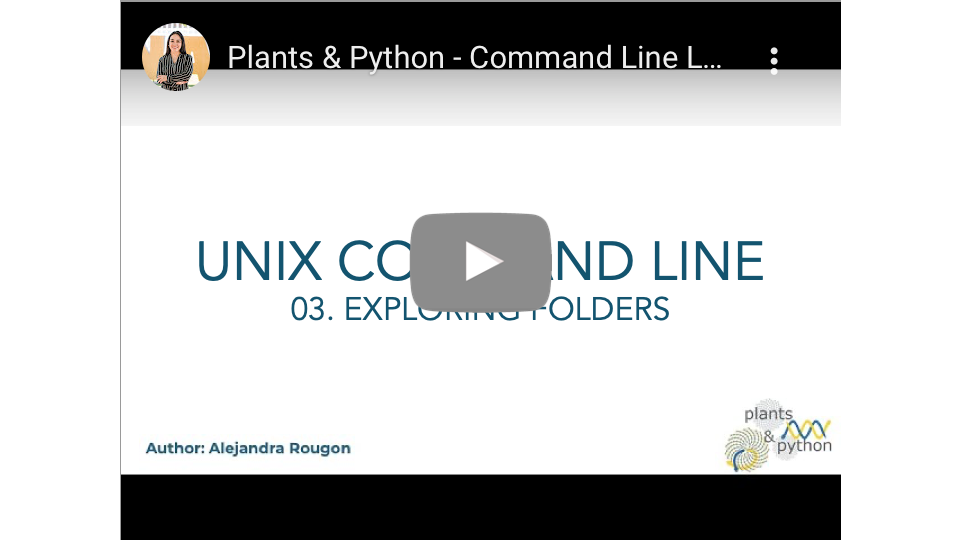5.2 Exploring Folders¶
Author: Dr. Alejandra Rougon

This work is licensed under a Creative Commons Attribution-NonCommercial 4.0 International License.
🔍 Learning Objectives¶
After completing this lesson you will learn to:
Identify the hierarchical file architecture
Print working directory
Change directory
Use absolute and relative paths
Create directories
Tab completion ↹
pwd, cd, ls, mkdir¶
Linux directory or folder structure is hierarchical, and referencing directories is accomplished by using the sequentially deeper directory name connected by forward slashes /. For example, in the following picture the folder project1 is inside my_docs which is at the same time, is inside the folder home. To reference its location we use `/home/my_docs/project1. This location reference is called a path.

There is a symbol called prompt that appears in the terminal when the system is ready for a new request. Depending on the shell that you are using, your prompt symbol will vary. For example, for bash, the prompt is a dollar sign $ and for zsh the prompt is a per cent sign %. If you are logged in as root, which is the main system administrator, you will have a hash # as a prompt.
Now, let’s go again to your Virtual Terminal at the CS50 sandbox. First we need to know in which folder are we standing. What is the path to our current working directory? And for that, we use the command pwd in our terminal. So, type the following (Remember that you don’t have to type in the $ since it is the command prompt that is already in your terminal).
Note: If at any time your command line gets stuck and you are not able to type anything in just press Ctrl c and whatever you where doing will be canceled.
$ pwd
and the output is the path to your current working directory
/root/sandbox
Now, let’s change directory. In order to move to a directory which is inside the directory you are working in, in other words, in order to move to a directory that is forward, you have to type the command cd space and the directory’s name.
$ cd Documents
and now verify it with pwd
$ pwd
/root/sandbox/Documents
Now your working directory is Documents. If you want to move one folder backward, that is to say, the directory that contains your working directory, you have to type cd ...
$ cd ..
$ pwd
/root/sandbox
In linux, we can reference a file or folder location, either, through an Absolute or a Relative path. Imagine that you want to give a friend the instructions to get from your home to the supermarket. So, you start, ‘go straight, then in the traffic lights turn left, and in the lamppost turn right and you will reach the supermarket’. This would be similar to the absolute path, which starts from the first directory on your system that is called root and it is represented by a /.
Now imagine that your friend is lost and calls you from the lamppost. You won’t give her the same directions. You will start from the lamppost and not from your home. So you will probably say, ‘turn right and you will reach the supermarket’. That would be similar to a relative path which starts from your working directory.


Now let’s move backward to the folder named root, using the absolute path
$ cd /root
$ pwd
/root
Now move to the system’s root directory which is the first directory of your system.
$ cd /
$ pwd
/
Now let’s type ls to list the directory contents
$ ls
bin/ dev/ home/ lib32/ media/ opt/ root/ sbin/ src/ sys/ usr/
boot/ etc/ lib/ lib64/ mnt/ proc/ run/ snap/ srv/ tmp/ var/
Go back to your home directory, which is usually the directory that has your user name. In the virtual terminal it is /root/sandbox/
$ cd
$ pwd
/root/sandbox
List the contents of your home folder (or sandbox)
$ ls
Documents/ Readme.txt
Go to Documents and create a new folder inside Documents called Genomes
$ cd Documents
$ mkdir Genomes
Go to the Genomes folder with the TAB key ↹
$ cd TAB
$ cd Genomes
🔑 In this lesson you have learned:
The hierarchical architecture of linux folders
pwdcommand for printing working directorycdcommand for changing directoryAbsolute and relative paths
mkdircommand for creating directorieslscommand for listing directory contents

